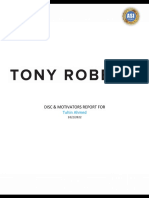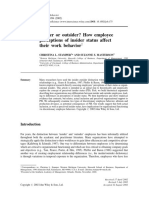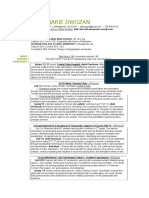DISC and Motivators
DISC and Motivators
Uploaded by
jymalinginCopyright:
Available Formats
DISC and Motivators
DISC and Motivators
Uploaded by
jymalinginOriginal Description:
Original Title
Copyright
Available Formats
Share this document
Did you find this document useful?
Is this content inappropriate?
Copyright:
Available Formats
DISC and Motivators
DISC and Motivators
Uploaded by
jymalinginCopyright:
Available Formats
DISC & MOTIVATORS REPORT FOR
John Rey Malingin
8/19/2023
Copyright © 2023 A24x7 TONY ROBBINS WWW.TONYROBBINS.COM
1
This report contains a summary of your DISC and Motivators results. If you are looking for
deeper insights into your results, see the last page of this report.
UNDERSTANDING DISC & MOTIVATORS
DISC STYLES
DISC is a simple, practical, easy to remember and universally applicable model. It focuses on individual patterns of
external, observable behaviors and measures the intensity of characteristics using scales of directness and openness
for each of the four styles: Dominance, Influence, Steadiness, and Conscientious.
Your DISC Style: Coach
Coaches bring a great trait, as they actively listen to others and provide sincere support for their efforts. They bring
sensitive insight when engaging with others and can make solid contributions without demanding to be the center of
attention. Coaches can diffuse tense situations with their insightful observations about the big picture and both
individual and group goals. They show both stability and engagement with others. They can increase effectiveness
with a bit more urgency and more specific direction to others.
Personal direction: Building personal connections and encouraging with positive feelings
Strengths offered: A skilled and sincere stabilizing force in both good and difficult times
General characteristics: Able to engage with people and be a sincere listener
Contributions to others: Builds sincere relationships with others and provides a listening ear
Getting along with others: Accepting and open attitude toward others
When stressed: May become non-committal and overly trusting
Keep in mind: May avoid taking a firm stand on divisive issues
Additional notes: A great coach for everyone, but may need to take a more decisive stand at times
Copyright © 2023 A24x7 TONY ROBBINS WWW.TONYROBBINS.COM
2
An Overview of Your DISC Style
Below are some key behavioral insights to keep in mind and share with others to strengthen your relationships.
John Rey, your score pattern suggests a high degree of persistence and patience in working on projects. This can be
especially important when the assignments are long, detailed, and involve a multitude of personal or complex tasks.
Where others may lose patience and perhaps allow overall quality to lapse, you bring a unique pulse and tempo that
can serve as a model for others.
You show a rare ability to get along with a wide variety of people. This comes from both your sincere interest in
people and from your inherent patience in working with others. You may be able to bring various individuals together
who might not otherwise cooperate.
You score like those who are socially poised without being overly controlling. You have the ability to project
confidence and poise that is perceived as sincere and genuine. Others are likely to notice this, allowing you to
develop trust and credibility with them easily.
Your response pattern to the instrument indicates that you have an empathetic listening style. As you know, this is a
rare gift. Some listening skills can be taught, but the inherent, sincere listening that you demonstrate is something
innate.
You score like those who prefer to establish long-term relationships, rather than brief, superficial ones. This perhaps
comes from your preference toward stability in your lifespace, and longer-term relationships may bring that stability.
Friendships and acquaintanceships you have made in the past are important to you, even now.
You have the ability to persuade others, not with hype, but rather with warmth, sincerity, and understanding. These
are perhaps considered "soft sell" tools, but they can make a big impact. This skill comes from the merging of your
"people skills," along with the fact that you tend to be more modest when dealing with people.
Copyright © 2023 A24x7 TONY ROBBINS WWW.TONYROBBINS.COM
3
An Overview of Your Motivators
Aesthetic - Strong desire and need to achieve equilibrium between the world around us and ourselves (within) while
creating a sustainable work/life balance between the two. Creative, imaginative, arty, mystical and expressive, this style may
redefine or resist real world approaches to current challenges.
Based on your Motivators assessment Aesthetic score: You will balance yourself between creative alternatives and practical
approaches without being extreme in either dimension.
• You possess a healthy balance between style, purpose, and function.
• You work equally well with practical and imaginative, self-expressive types.
• You can appreciate others' needs to express their creativity.
• You can work well with others to create and transform.
Economic - The motivation for security from self-interest, economic gains, and achieving real-world returns on personal
ventures, personal resources, and focused energy. The preferred approach of this motivator is both a personal and a
professional one with a focus on ultimate outcomes.
Based on your Motivators assessment Economic score: You will balance yourself between being satisfied with what you have
and a need for more.
• You are realistic and down-to-earth in regards to getting what you believe you deserve.
• Your score indicates a balance between being satisfied with what you have and the need for more.
• Your score indicates that there would be no excessive need to win when engaging with others.
• You have the ability to identify with individuals who have both high and low satisfaction rates.
Individualistic - Need to be seen as autonomous, unique, independent, and to stand apart from the crowd. This is the
drive to be socially independent and have opportunity for freedom of personal expression apart from being told what to do.
Based on your Motivators assessment Individualistic score: You appreciate what others bring to the table and may be apt to
become the unsung hero of any project or team.
• You will likely support others while rarely focusing on gaining the personal support you may want or need.
• You may never make the necessary noise surrounding important issues and may set yourself up for being overlooked.
• Since the squeaky wheel gets the grease, you'll need to speak up to be noticed more.
• Because you don't seek attention for your efforts, you may be left feeling like a ghost, never drawing attention to yourself.
Power - Being seen as a leader, while having influence and control over one's environment and success. Competitiveness
and control is often associated with those scoring higher in this motivational dimension.
Based on your Motivators assessment Power score: You can mediate all available ideas without an excessive need to control
outcomes.
• You're a stabilizing force in normal team operations and will lead if necessary, but you don't need to.
• You can be both cooperative and competitive depending on the situation at hand.
• You will likely be on board with leaders who are competent, but may struggle with leaders who seem unskilled.
• You are able to understand both aggressive and passive leaders.
Copyright © 2023 A24x7 TONY ROBBINS WWW.TONYROBBINS.COM
4
An Overview of your Motivators - Continued
Altruistic - An expression of the need or energy to benefit others at the expense of self. At times, there’s genuine sincerity
in this dimension to help others, but not always. Oftentimes an intense level within this dimension is more associated with
low self-worth.
Based on your Motivators assessment Altruistic score: You will make sure you position yourself, so you don’t get burned
when working closely with others.
• You will be difficult to take advantage of most of the time.
• You will likely be determined in chaos.
• You probably have low tolerance for people who complain and whine about their problems.
• You will not likely be moved by emotional appeals or sad faces.
Regulatory - A need to establish order, routine and structure. This motivation is to promote a black and white mindset and
a traditional approach to problems and challenges through standards, rules, and protocols to color within the lines.
Based on your Motivators assessment Regulatory score: You believe there’s only one way to solve a problem and will
endeavor to work within established boundaries.
• You are likely looking for a cause and a purpose to live up to.
• You'll hold others to your standards and may become vengeful when people break your rules.
• If you're breaking a moral code, you'll justify it.
• You probably believe there's only one-way to get things done: your way.
Theoretical - The desire to uncover, discover, and recover the "truth.” This need to gain knowledge for knowledge sake is
the result of an “itchy” brain. Rational thinking (frontal lobe), reasoning and problem solving are important to this dimension.
This is all about the “need” to know why.
Based on your Motivators assessment Theoretical score: You can rely on both new information and what has worked in the
past when making decisions.
• You want to know why, but won't let it get in your way of getting things done.
• You are a "situational" learner.
• You can just figure things out and get to the bottom of it without having to study too much.
• You understand that investigation is necessary, but you will rarely over-investigate any issue.
Copyright © 2023 A24x7 TONY ROBBINS WWW.TONYROBBINS.COM
5
A General Overview of the Four DISC Styles
The Dominant ‘D’ Style: look at my accomplishments!
Goals and Fears
Dominant ‘D’ Styles, driven by the inner need to lead and be in personal control, take charge of people and situations
so they can reach their goals. Since their key need is achieving, they seek no-nonsense, bottom line results. Their
motto is: "Lead, follow, or get out of the way." They want to win, so they may challenge people or rules. Similarly,
Dominant ‘D’ Styles also accept challenges, take authority, and go head first into solving problems. Closely related to
Dominant ‘D’ Styles' goals are their fears: falling into a routine, being taken advantage of, and looking "soft". So, they
may go to extremes to prevent those fears from materializing. They may act impatient, but they make things happen.
"Do as I say"
Since Dominant ‘D’ Styles need to have control, they like to take the lead in both business and social settings. As
natural renegades, they want to satisfy their need for autonomy. They want things done their way or no way at all.
Strengths and weaknesses
They work quickly and impressively by themselves. They try to shape their environments to overcome obstacles en
route to their accomplishments. They seek maximum freedom to manage themselves and others, using their
leadership skills to become winners. They often have good administration and delegation skills.
These assertive types tend to appear cool, independent, and competitive. They opt for measurable results, including
their own personal worth, as determined by individual track records. Of all the types, they like and initiate changes
the most. We symbolize this personality type with a lion--a leader, an authority. At least, they may, at least, have the
inner desires to be #1, the star, or the chief.
Less positive Dominant ‘D’ Style components include stubbornness, impatience, and toughness. Naturally preferring
to take control of others, they may have a low tolerance for the feelings, attitudes, and "inadequacies" of co-workers,
subordinates, friends, families, and romantic interests.
From general to specific
Dominant ‘D’ Styles process data conceptually by using deductive reasoning--from general to specific information.
They are more comfortable using the left brain more than the right. When combined with their need for control, this
helps us better understand the emphasis on getting down to the bottom-line results.
Masters of "mind control"
They are adept at blocking out distractions when they immerse themselves in projects. They don't hear voices, sirens,
or doorbells. They seem to channel all their energies into specific jobs.
Venting relieves their tension
Under pressure, Dominant ‘D’ Styles are likely to rid themselves of anger by ranting, raving, or challenging others.
They naturally react to tense situations with a fight response. Although this venting allows the relief of their own
inner tensions, other styles may feel intimidated by this stress reducing practice. But the Dominant ‘D’ Styles' barks
usually exceed their bites, and they may soon forget what specifically upset them in the first place.
Copyright © 2023 A24x7 TONY ROBBINS WWW.TONYROBBINS.COM
6
The Interacting ‘I’ Style: hey, look at me!
Outgoing, Supporting, Interacting ‘I’ Styles
Interacting ‘I’ Styles like to go where the action is. Typically, they are outwardly energetic or fast-paced, and
relationships tend to naturally take priority over tasks. They try to influence others in an optimistic, friendly way
focused on positive outcomes, whether in the social or work environment. In other words, if they show others that
they like them, they figure others will be more likely to reciprocate by responding favorably towards them. Since
recognition and approval motivate him, he often moves in and around the limelight and hub of activity.
Goals and Fears
He wants your admiration and thrives on acknowledgment, compliments, and applause. "It's not just whether you
win or lose. . .it's how you look when you play the game." People's admiration and acceptance typically mean more
to this type than to any other. If you don't talk about him, he may spend considerable time talking about his favorite
subject--himself--to gain the acceptance he wants. His biggest fear is public humiliation--whether appearing
uninvolved, unattractive, unsuccessful, or unacceptable to others. These frightening forms of social rejection
threaten the Interacting ‘I’ Style's core need for approval. Consequently, he may go to extremes to avoid public
humiliation, lack of inclusion, or loss of social recognition.
Strengths and weaknesses
Interacting ‘I’ Styles' primary strengths are their enthusiasm, persuasiveness, and friendliness. They are idea people
who have the ability to get others caught up in their dreams. With great persuasion, they influence others and shape
their environments by building alliances to accomplish results. Then they seek nods and comments of approval and
recognition for those results. If compliments don't come, Interacting ‘I’ Styles may invent their own. "Well, Harry, I
just feel like patting myself on the back today for a job well done!" They are stimulating, talkative, and
communicative. This type can be represented by a porpoise--playful, sociable, and talkative.
Their natural weaknesses are too much involvement, impatience, being alone, and short attention spans. This causes
them to become easily bored. When a little data comes in, Interacting ‘I’ Styles tend to make sweeping
generalizations. They may not check everything out, assuming someone else will do it or procrastinating because
redoing something just isn't exciting enough. When Interacting ‘I’ Styles feel they don't have enough stimulation and
involvement, they get bored and look for something new again. . .and again. . .and again. When taken to an extreme,
their behaviors can be seen as superficial, haphazard, erratic, and overly emotional.
"Let me entertain you!"
If they pursue the entertainment field for careers, Interacting ‘I’ Styles typically allow their natural, animated
emotions to show and flow. They become stimulated by the movement and reactions of the audience, trying to get
the audience to figuratively fall in love with them by acting charming and friendly. They want viewers to feel, "He (or
she) is fabulous!"
Copyright © 2023 A24x7 TONY ROBBINS WWW.TONYROBBINS.COM
7
The Steady ‘S’ Style: notice how well-liked I am
Goals and fears
Steady ‘S’ Styles seek your sincere personal attention and acceptance of them. Steadiness and follow-through actions
characterize these people. They prefer a slower and easier pace. They focus on building trust and getting acquainted
because they aim for long-standing personal relationships. Pushy, aggressive behavior secretly irritates them.
They strive for security. Their goal is to maintain the stability they prefer in a more constant environment. To Steady
‘S’ Styles, while the unknown may be an intriguing concept, they prefer to stick with what they already know and
have experienced. "Risk" is an ugly word to them. They favor more measured actions, like keeping things as they
have been and are, even if the present situation happens to be unpleasant due to their fear of change and
disorganization. Consequently, any disruption in their routine patterns can cause distress in them. A general worry is
that the unknown may be even more unpleasant than the present. They need to think and plan for changes. Finding
the elements of sameness within those changes can help minimize their stress to cope with such demands.
Strengths and weaknesses
Steady ‘S’ Styles naturally "wear well" and are an easy type to get along with. They prefer stable relationships which
don't jeopardize anyone, especially themselves. Steady ‘S’ Styles can be represented by the koala with its
accompanying slower, steady pace; relaxed disposition; and appearance of approachability and warmth. Steady ‘S’
Styles have a tendency to plan and follow through. This helps them to routinely plug along. But they have their own
type of unique difficulties with speaking up, seeming to go along with others or conditions, while inwardly, they may
or may not agree. More assertive types might take advantage of this Steady ‘S’ Style tendency to give in and avoid
confrontation. Additionally, Steady ‘S’ Styles' reluctance to express themselves can result in hurt feelings. But if
Steady ‘S’ Styles don't explain their feelings, others may never know. Their lack of assertiveness can take a toll on this
type's health and well-being.
Take it slow
Steady ‘S’ Styles yearn for more tranquility and security in their lives than the other three types. They often act
pleasant and cooperative, but seldom incorporate emotional extremes such as rage and euphoria in their behavioral
repertoire. Unlike Interacting ‘I’ Styles, Steady ‘S’ Styles usually experience less dramatic or frequently-occurring
peaks and valleys to their more moderate emotional state. This reflects their natural need for composure, stability,
and balance.
"Just plain folks"
Steady ‘S’ Styles lend a tone of continuity, coziness, and project a genuine liking and acceptance of others. They are
comfortable people to watch and listen to who emanate that "I'm just a regular person" modesty. They put on no
airs and project contentment with present conditions--just as they are and always have been.
Copyright © 2023 A24x7 TONY ROBBINS WWW.TONYROBBINS.COM
8
The Conscientious ‘C’ Style: notice my efficiency
Goals and fears
Conscientious ‘C’ Styles concern themselves more with content than with congratulations. They prefer involvement
with the performance of products and services under specific, and preferably controlled, conditions so the process
and the results can be correct. Since their primary concern is accuracy, human emotions may take a back seat with
them. Their biggest fears of uncontrolled emotions and irrational acts relate to their fear that these illogical acts may
prevent goal achievement. Similarly, they fear emotionality and irrationality in others. They strive to avoid
embarrassment, so they attempt to control both themselves and their emotions.
Strengths and weaknesses
Conscientious ‘C’ Style strengths include accuracy, dependability, independence, clarification and testing skills,
follow-through, and organization. They often focus on expectations (e.g., policies, practices, and procedures) and
outcomes. They want to know how things work so they can evaluate how correctly they function. Conscientious ‘C’
Styles can be cagey, resourceful, and careful. Because they need to be right, they prefer checking processes
themselves. This tendency toward perfectionism, taken to an extreme, can result in "paralysis by over analysis".
These overly cautious traits may result in worry that the process isn't progressing right, which further promotes their
tendency to behave in a more critical, detached way.
Complex and serious
They prefer tasks over people, clearly defined priorities, and a known pace which is agreeable to them, especially
where task timelines and deadlines are involved. Other types typically live life through a single predominant time
orientation--past, present, or future. But Conscientious ‘C’ Styles are apt to be concerned about all three, as one
aspect of their complex mental makeup. They tend to see the serious, more complicated sides of situations as well as
the lighter--or even bizarre side--which accounts for their natural mental wit.
Conscientious ‘C’ Styles concentrate on making decisions in both logical and cautious ways to ensure that they take
the best available action.
Think deeply
Due to compliance to their own personal standards, they demand a lot from themselves and others and may
succumb to overly critical tendencies. But Conscientious ‘C’ Styles often keep their criticisms to themselves,
hesitating to tell people what they think is deficient. They typically share information, both positive and negative,
only on a "need to know" basis when they are assured that there will be no negative consequences for themselves.
When Conscientious ‘C’ Styles quietly hold their ground, they do so as a direct result of their proven knowledge of
facts and details or their evaluation that others will tend to react less assertively. So, they can be assertive when they
perceive they're in control of a relationship or their environment. Having determined the specific risks, margins of
error, and other variables which significantly influence the desired results, they will take action.
Copyright © 2023 A24x7 TONY ROBBINS WWW.TONYROBBINS.COM
9
Three Upgrade Options to get a better understanding of YOUR style!
Complete DISC + Motivators Combined Report AND a one-on-one DISC strategy session
with one of Tony’s top Results Coaching Strategists ($99.97)
Get the report the pros use! See every data point, graph, chart, statement set, and prescriptive
recommendation, specific to your unique behavioral and motivational styles.
As a BONUS
Get the Tony Robbins Personal Coaching Collection – his classic training program that will help
you discover greater joy, impact, and fulfillment in your everyday life.
A one-on-one DISC strategy session with one of Tony’s top Results Coaching Strategists ($250
value!) to convert your newly-discovered personal knowledge into powerful action.
Click Below to Upgrade! - View a Sample Report
https://assessment.tonyrobbins.com/disc-results-page/?e=mr.rey316@gmail.com&i=17ab04181e53426ba6ae9225698b6db6
When you return to your Results page, click the blue UPGRADE REPORT button to view options and make a purchase.
Complete DISC + Motivators Combined Report ($59.00)
Get the report the pros use! See every data point, graph, chart, statement set, and prescriptive
recommendation, specific to your unique behavioral and motivational styles.
As a BONUS
Get the Tony Robbins Personal Coaching Collection – his classic training program that will help
you discover greater joy, impact, and fulfillment in your everyday life.
Click Below to Upgrade! - View a Sample Report
https://assessment.tonyrobbins.com/disc-results-page/?e=mr.rey316@gmail.com&i=17ab04181e53426ba6ae9225698b6db6
When you return to your Results page, click the blue UPGRADE REPORT button to view options and make a purchase.
4-page report detailing your DISC and Motivators scores and graphs ($24.97)
Send your employer, prospective employer, or staffing company and share the additional personal
insights that only come from seeing your scoring data.
Click Below to Upgrade! - View a Sample Report
https://assessment.tonyrobbins.com/disc-results-page/?e=mr.rey316@gmail.com&i=17ab04181e53426ba6ae9225698b6db6
When you return to your Results page, click the blue UPGRADE REPORT button to view options and make a purchase.
Kids DISC
If you’d like similar insights about the kids in your life, give them the
Kids DISC assessment. The Kids DISC report offers significant insights
with three distinct sections for kids, parents, and teachers. This report
contains helpful information for children and the adults in their lives.
Click for Kids DISC!
Copyright © 2023 A24x7 TONY ROBBINS WWW.TONYROBBINS.COM
10
How to Assure Assessment Accuracy? Independent & Qualified Testing at Standards
Set by the APA and EEOC.
“…this DISC assessment has one of the highest Cronbach scores in the DISC marketplace.”
“...we applaud your efforts at making Motivators reliable and valid..”
- Assessment Standards Institute
The Assessment Industry’s Past and Present
Assessments have been used since the mid-20th century, initially relied upon by Fortune 500s, calculated by highly skilled PhDs and
produced by only a handful of trusted developers. With the advent of the internet in the 1990s, the ability to produce, market, and sell
assessments became exponentially easier and less expensive. Since then, it has developed into a kind of “global cottage industry” with
hundreds of new assessment developers, producing thousands of different assessments. Each developer purporting its assessments to be
scientifically accurate instruments - sold, resold and used by individuals and organizations of all kinds; including many of our largest
institutions like Fortune 500s, major universities, world governments, and even military. Frighteningly, this “global cottage industry,” which
produces data relied upon by millions, is entirely unregulated with nothing to ensure its consumers are receiving what they are being told
and sold. There are zero requirements, safeguards, laws or regulations ensuring the consumer receives a scientifically accurate instrument
- or even what the developers and sellers claim.
The Solution? Independent & Verifiable Testing by a Qualified Institution
The Assessment Standards Institute (ASI) provides our assessments with verifiably objective testing and reporting that meet standards set
by the American Psychological Association (APA) and the Equal Employment Opportunity Commission (EEOC). This battery of tests is
both voluntary and verifiably transparent. Our goal? To ensure this assessment’s professional merit and scientific accuracy for you, the
user. These reports are readily available upon request and include:
Construct Validity (APA Standards) [DISC & Motivators]
Construct validity is one of the most central concepts in psychology. It is the degree to which a test measures what it claims, or purports to
be measuring. Researchers generally establish the construct validity of a measure by correlating it with a number of other measures and
arguing from the pattern of correlations that the measure is associated with these variables in theoretically predictable ways.
Reliability - Cronbach’s alpha (APA Standards) [DISC]
This technique is regarded as one of the most robust measures of reliability and presents the highest 'bar' from which to compare. The
readers should note that Cronbach's alpha is the method selected for this instrument, because of its high standards. The reader is
encouraged to compare reliability coefficients presented herein to other vendors, and also to ask those vendors which reliability formulas
they used to compute their reliability coefficients. Cronbach’s alpha is a measure used to assess the reliability, or internal consistency, of a
set of scale or test items. In other words, the reliability of any given measurement refers to the extent to which it is a consistent measure
of a concept, and Cronbach’s alpha is one way of measuring the strength of that consistency.
External Data Reliability (APA Standards) [Motivators]
The term reliability in psychological research refers to the consistency of a testing or assessment method. In this case we are measuring
the reliability or consistency of assessment measures over time. External Reliability measures the extent to which assessment measure
varies from one use to another. In this analysis we are measuring reliability from the use of a test at one time as compared to another
time. The comparison is using a mean variance measure referred to as the mean value ratio. The mean value ratio measures the external
or time consistency of an assessment.
Disparate Impact (EEOC Guidelines) [DISC & Motivators]
Employers often use tests and other selection procedures to screen applicants for hire and employees for promotion. The use of tests and
other selection procedures can be a very effective means of determining which applicants or employees are most qualified for a job.
However, use of these tools can also violate the EEOC Guidelines if they disproportionately exclude people in a protected group by class,
race, sex, or another covered basis. Importantly, the law does allow for selection procedures to select the best candidates based on job
related requirements. If the selection procedure has a disparate impact based on race, color, religion, sex, or national origin, the employer
is required to show that the selection procedure is job related and consistent with business necessity. If discrimination exists, the
challenged policy or practice should therefore be associated with the skills needed to perform the job successfully.
ASI Validation Reports
Additional details and published reports - DISC and Motivators (Disparate Impact) and (Reliability/Construct Validity)
Copyright © 2023 A24x7 TONY ROBBINS WWW.TONYROBBINS.COM
11
You might also like
- Tugas Self Insight LeadershipDocument26 pagesTugas Self Insight LeadershipMuhammad FadillahNo ratings yet
- 110 Psychology Dissertation TopicsDocument6 pages110 Psychology Dissertation TopicsJoel Bibbs100% (5)
- DISC - and - Motivators Sample ResultsDocument11 pagesDISC - and - Motivators Sample ResultsPatrisha anne PaviaNo ratings yet
- Parrondo Abril DISC and MotivatorsDocument11 pagesParrondo Abril DISC and MotivatorsAbril 03No ratings yet
- Sanchez Veronica DISC and MotivatorsDocument11 pagesSanchez Veronica DISC and MotivatorsVeronica SanchezNo ratings yet
- Erina Ira DISC and MotivatorsDocument11 pagesErina Ira DISC and MotivatorsiraalerinaNo ratings yet
- Gumarac Melchor DISC and MotivatorsDocument11 pagesGumarac Melchor DISC and MotivatorsMelchor GumaracNo ratings yet
- Kumar Azit DISC and MotivatorsDocument11 pagesKumar Azit DISC and MotivatorsAjitkumar PulagurthaNo ratings yet
- Perillo Kenneth DISC and MotivatorsDocument11 pagesPerillo Kenneth DISC and MotivatorsKenneth PerilloNo ratings yet
- Morales Emmerson DISC and MotivatorsDocument11 pagesMorales Emmerson DISC and MotivatorsEmmerson MoralesNo ratings yet
- Johnson Joseph DISC and MotivatorsDocument11 pagesJohnson Joseph DISC and Motivators47jbfr5cmkNo ratings yet
- Lasola Hans Arber Disc and MotivatorsDocument11 pagesLasola Hans Arber Disc and Motivatorshans arber lasolaNo ratings yet
- Disc MotivatorsDocument11 pagesDisc MotivatorsJeffrey HerreraNo ratings yet
- Avila Rolito Jr. DISC and MotivatorsDocument11 pagesAvila Rolito Jr. DISC and MotivatorsRolito AvilaNo ratings yet
- Leonen Aleah Mae DISC and MotivatorsDocument11 pagesLeonen Aleah Mae DISC and Motivatorsabbyleonen5No ratings yet
- Zambrano Hannah Trixie DISC and MotivatorsDocument11 pagesZambrano Hannah Trixie DISC and Motivatorszambrano.hannahtrixieNo ratings yet
- Andiza Lucky DISC and MotivatorsDocument11 pagesAndiza Lucky DISC and MotivatorsLucky AndizaNo ratings yet
- Paz Diaz Jorge Erickson DISC and MotivatorsDocument11 pagesPaz Diaz Jorge Erickson DISC and MotivatorsJorge PazNo ratings yet
- Esaga Princess Denere DISC and MotivatorsDocument11 pagesEsaga Princess Denere DISC and MotivatorsPrincess Denere EsagaNo ratings yet
- NenejwhuwDocument11 pagesNenejwhuwnnek7089No ratings yet
- Densing Wauie DISC and MotivatorsDocument11 pagesDensing Wauie DISC and Motivatorswauie densingNo ratings yet
- Roque Dan DISC and MotivatorsDocument11 pagesRoque Dan DISC and MotivatorscasiornplaysNo ratings yet
- DISC and MotivatorsDocument11 pagesDISC and Motivatorsbnxrrrgj5xNo ratings yet
- Barrozo Luckriza DISC and MotivatorsDocument11 pagesBarrozo Luckriza DISC and Motivatorsscreabb lerNo ratings yet
- Eremeev - Victoria - DISC - and - Motivators 2Document11 pagesEremeev - Victoria - DISC - and - Motivators 2vicvic88No ratings yet
- Alcaba Freshan Noveth DISC and MotivatorsDocument11 pagesAlcaba Freshan Noveth DISC and MotivatorsShan ANo ratings yet
- Tony RobinsDocument11 pagesTony Robinsjlatienza436No ratings yet
- MENDOZA ANA LEE DISC and MotivatorsDocument11 pagesMENDOZA ANA LEE DISC and MotivatorsANA LEE MENDOZANo ratings yet
- Pasoot Marco Yvan DISC and MotivatorsDocument11 pagesPasoot Marco Yvan DISC and MotivatorsMarco YvanNo ratings yet
- Balo Quenie Dianne DISC and Motivators PDFDocument10 pagesBalo Quenie Dianne DISC and Motivators PDFQuenieNo ratings yet
- Herrera Jose DISC and MotivatorsDocument11 pagesHerrera Jose DISC and MotivatorsJose HerreraNo ratings yet
- Aritya Putri Fena Rizki Disc and MotivatorsDocument11 pagesAritya Putri Fena Rizki Disc and MotivatorsFena ArityaNo ratings yet
- Christopher_DISC_and_MotivatorsDocument11 pagesChristopher_DISC_and_Motivatorskaren.sanjuan5No ratings yet
- Alburo Anna Marie DISC and MotivatorsDocument11 pagesAlburo Anna Marie DISC and MotivatorsAnna Marie A. AlburoNo ratings yet
- Ahmed Tuhin DISC and MotivatorsDocument11 pagesAhmed Tuhin DISC and Motivatorstuhin.ahmedNo ratings yet
- DISC and MotivatorsDocument11 pagesDISC and Motivatorsgirlee manlaviNo ratings yet
- Tejero Charles Mclin DISC and MotivatorsDocument11 pagesTejero Charles Mclin DISC and MotivatorsCharles Mclin TejeroNo ratings yet
- DISC and MotivatorsDocument11 pagesDISC and MotivatorsJenny CelestinoNo ratings yet
- Macalino Jeffrey DISC and MotivatorsDocument11 pagesMacalino Jeffrey DISC and MotivatorsJeffrey MacalinoNo ratings yet
- Parco Mariah Moira DISC and MotivatorsDocument11 pagesParco Mariah Moira DISC and MotivatorsMoira ParcoNo ratings yet
- Jessa Mae DISC and MotivatorsDocument11 pagesJessa Mae DISC and MotivatorsAutumn ThirteenNo ratings yet
- DISC and MotivatorsDocument11 pagesDISC and MotivatorsShahir S.No ratings yet
- Dondoyano Elijah DISC and MotivatorsDocument11 pagesDondoyano Elijah DISC and MotivatorsElijah DondoyanoNo ratings yet
- Gibas Joandrew DISC and MotivatorsDocument11 pagesGibas Joandrew DISC and Motivatorsbrandonberg122786No ratings yet
- Maria Chabelie Violago AmaganDocument11 pagesMaria Chabelie Violago AmaganKENEDY FLORESNo ratings yet
- Parco Mariah Moira DISC and Motivators 2Document11 pagesParco Mariah Moira DISC and Motivators 2Taylors VersionNo ratings yet
- Pradicta Moh Vicky Indra DISC and Motivators-1Document11 pagesPradicta Moh Vicky Indra DISC and Motivators-1Mohammad PradictaNo ratings yet
- Sarcia Toby Bruce DISC and MotivatorsDocument11 pagesSarcia Toby Bruce DISC and MotivatorsTOBY BRUCE SARCIANo ratings yet
- SILVA - MESARIE - DISC - and - Motivators 2Document11 pagesSILVA - MESARIE - DISC - and - Motivators 2SILVA, MESARIE Q.No ratings yet
- Paula Carmela DISC and MotivatorsDocument11 pagesPaula Carmela DISC and MotivatorsPaula J.No ratings yet
- Cuevas Ian Vergel DISC and MotivatorsDocument11 pagesCuevas Ian Vergel DISC and MotivatorsIan Vergel CuevasNo ratings yet
- Disc and Values _ ALyzah Lois MaturanDocument11 pagesDisc and Values _ ALyzah Lois MaturanalyzahNo ratings yet
- Endrina Jhonpaul DISC and MotivatorsDocument12 pagesEndrina Jhonpaul DISC and MotivatorsjhonpualendrinaaNo ratings yet
- villanueva_caXizalez_maria_de_los_angeles_DISC_and_MotivatorsDocument12 pagesvillanueva_caXizalez_maria_de_los_angeles_DISC_and_MotivatorsmariavillanuevacanNo ratings yet
- ArceXo Kenneth DISC and MotivatorsDocument11 pagesArceXo Kenneth DISC and MotivatorsKei ArceñoNo ratings yet
- Chandra Sekar KANNAN DISC and MotivatorsDocument11 pagesChandra Sekar KANNAN DISC and Motivatorskannan000No ratings yet
- Hernanda Adhira DISC and MotivatorsDocument11 pagesHernanda Adhira DISC and MotivatorsAdhira Hernanda Nurul UrfahNo ratings yet
- Amor Edjean Marie DISC and MotivatorsDocument11 pagesAmor Edjean Marie DISC and MotivatorsMiii AmorNo ratings yet
- Kate Lady DISC and MotivatorsDocument11 pagesKate Lady DISC and MotivatorsNurul Eka LestariNo ratings yet
- Villarete George Axl DISC and MotivatorsDocument12 pagesVillarete George Axl DISC and MotivatorsJumai PradoNo ratings yet
- Viola Mary Joy DISC and MotivatorsDocument11 pagesViola Mary Joy DISC and MotivatorsMary Joy SarteNo ratings yet
- Leading Through Transitions Participant Workbook One-Day WorkshopFrom EverandLeading Through Transitions Participant Workbook One-Day WorkshopNo ratings yet
- Implications For Line Managers and Employees in Developing A Strategic Approach To HRMDocument3 pagesImplications For Line Managers and Employees in Developing A Strategic Approach To HRMRakib Chowdhury75% (4)
- Overexcitabilities by Piechowski 1999Document10 pagesOverexcitabilities by Piechowski 1999jcbazinetNo ratings yet
- Anal IntercourseDocument16 pagesAnal Intercourseagustin cassinoNo ratings yet
- Transfer of TrainednessDocument2 pagesTransfer of Trainednessmakijato954649No ratings yet
- The Effects of Uncertainty Avoidance On Interaction in The ClassroomDocument10 pagesThe Effects of Uncertainty Avoidance On Interaction in The ClassroomMacec Ancuta Elena LigiaNo ratings yet
- The Transition of Leadership in The Family Business From Father To Daughter.Document11 pagesThe Transition of Leadership in The Family Business From Father To Daughter.kaja6igli6No ratings yet
- IPPD Marjorie RamirezDocument2 pagesIPPD Marjorie RamirezMarjorie RamirezNo ratings yet
- 2002 Stamper Insider-Outsider JOBDocument21 pages2002 Stamper Insider-Outsider JOBVictor LAU (MGT)No ratings yet
- 7th Grade Science Class Behavior ContractDocument1 page7th Grade Science Class Behavior Contractapi-343241309No ratings yet
- Comparison of CBT and Rebt1Document6 pagesComparison of CBT and Rebt1Oti VuraNo ratings yet
- Week 10 11 Lifespan SP Need - 20182019Document92 pagesWeek 10 11 Lifespan SP Need - 20182019Ron ChongNo ratings yet
- P Oor Enrollment of Male Student Into TVLDocument3 pagesP Oor Enrollment of Male Student Into TVLJoana ValdezNo ratings yet
- Mental Health in The Kingdom of GodDocument9 pagesMental Health in The Kingdom of GodCharles TewerNo ratings yet
- Lesson Plan VetDocument4 pagesLesson Plan Vetapi-216183591No ratings yet
- The ResumeDocument2 pagesThe Resumeapi-294168248No ratings yet
- Computer Science Proposal (Aauysh S.)Document10 pagesComputer Science Proposal (Aauysh S.)bashyalanshulNo ratings yet
- K02873 - 20180529172129 - Chapter 14 Hergenhahn 7e FinalDocument38 pagesK02873 - 20180529172129 - Chapter 14 Hergenhahn 7e Finalzuh blackNo ratings yet
- CFQ and Its CorrelatesDocument16 pagesCFQ and Its CorrelatesBogdan BNo ratings yet
- Adolescent FrustrationDocument14 pagesAdolescent FrustrationNeetaNo ratings yet
- Management PhilosophyDocument2 pagesManagement PhilosophyJoslyn BomgaarsNo ratings yet
- Behavior Based Safety PowerpointmDocument23 pagesBehavior Based Safety Powerpointmprashant100% (1)
- Ardichvili Manderscheid 2008 Emerging Practices in Leadership Development An IntroductionDocument13 pagesArdichvili Manderscheid 2008 Emerging Practices in Leadership Development An Introductionraki090No ratings yet
- B InggrisDocument3 pagesB InggrisHermasdito SrsNo ratings yet
- Overcoming Inappropriate Behavior PatternsDocument6 pagesOvercoming Inappropriate Behavior PatternsLawrence W Spearman100% (3)
- The Near-Death Experience NDE As An Inhe PDFDocument14 pagesThe Near-Death Experience NDE As An Inhe PDFgNo ratings yet
- Domestic Violence and Its Impact On ChildrenDocument4 pagesDomestic Violence and Its Impact On ChildrenIOSRjournalNo ratings yet
- Children'S Feelings and Experiences in A Selected Evacuation Center in The PhilippinesDocument35 pagesChildren'S Feelings and Experiences in A Selected Evacuation Center in The PhilippinesDomNo ratings yet
- OB MBS Unit 5 Positive Organizational BehaviourDocument22 pagesOB MBS Unit 5 Positive Organizational BehaviourNabin Sijali0% (1)

























































































